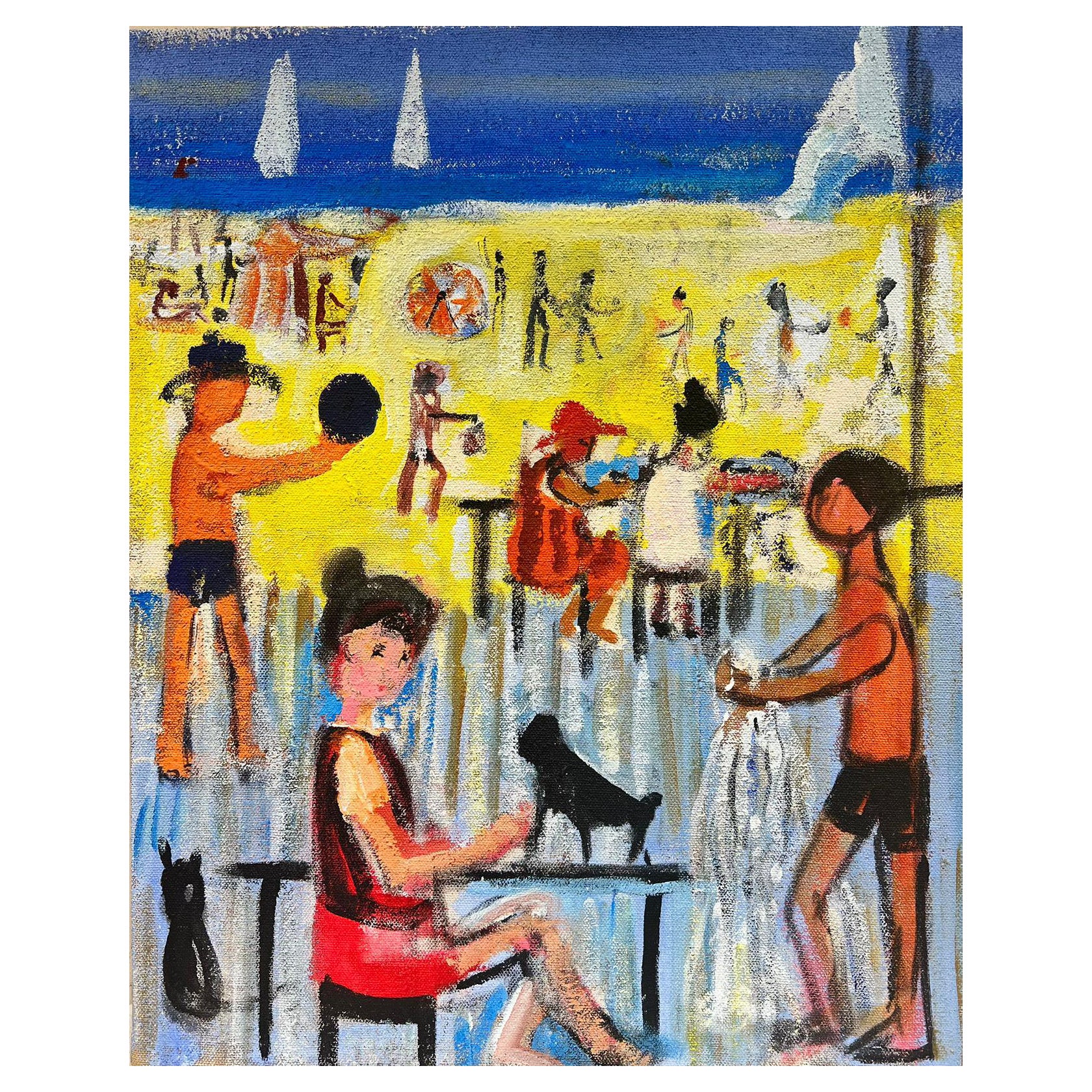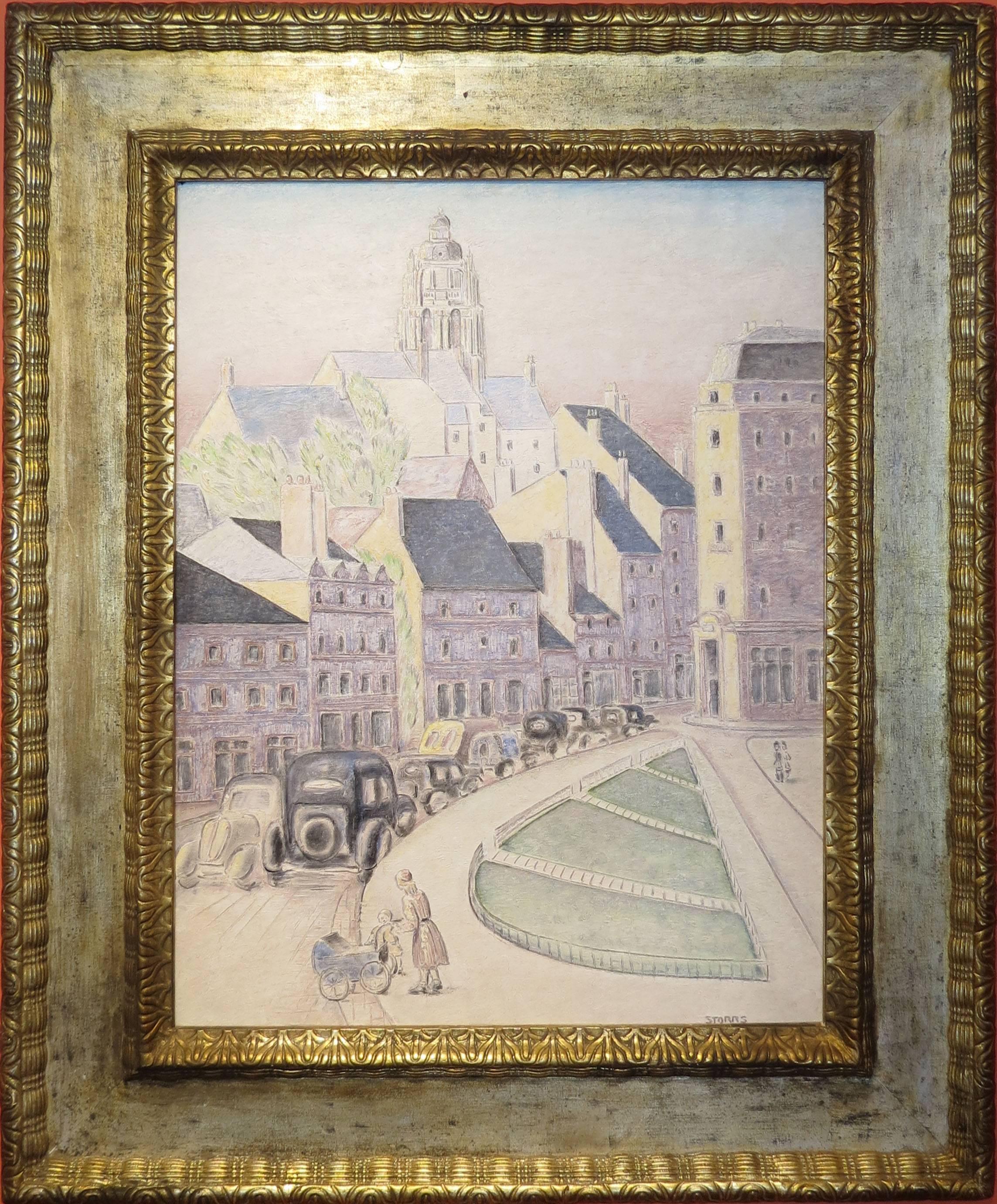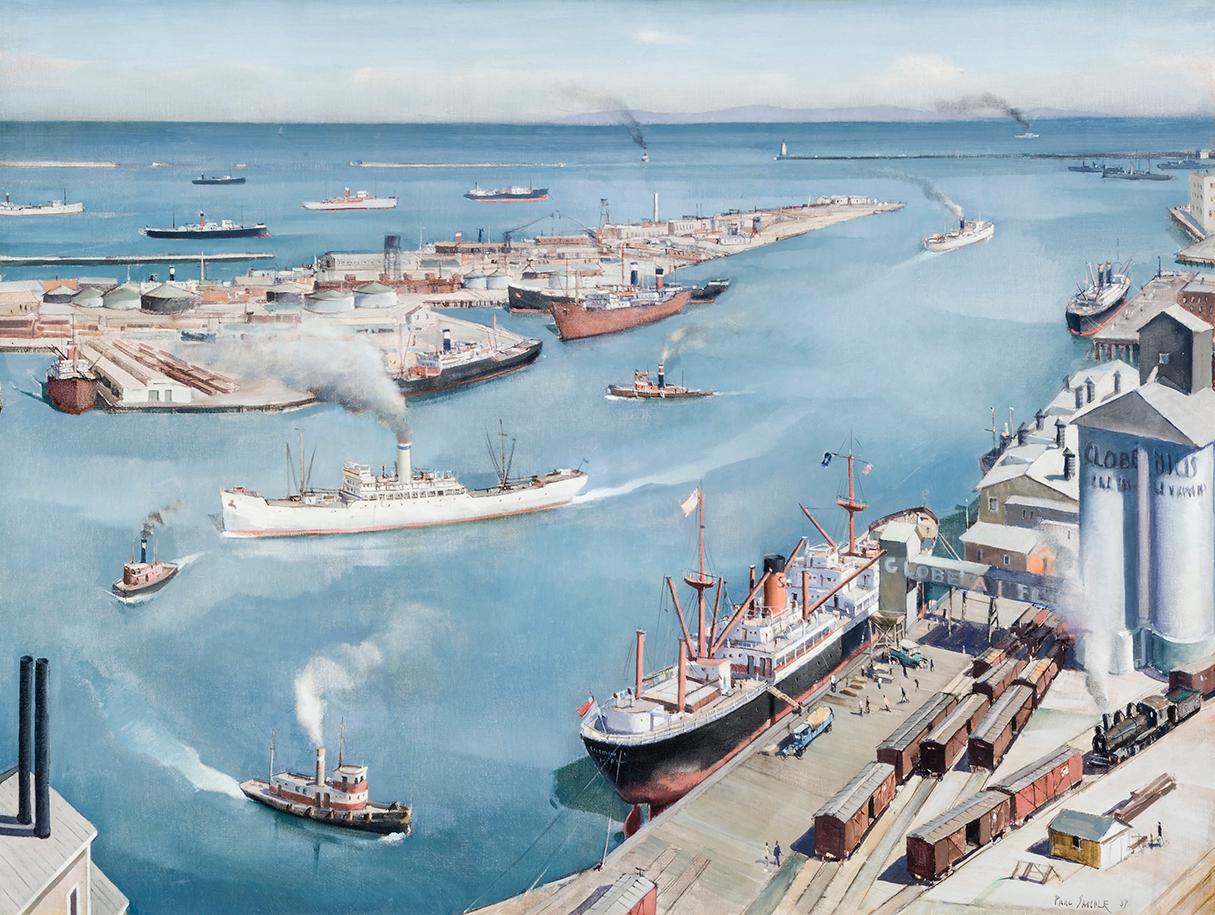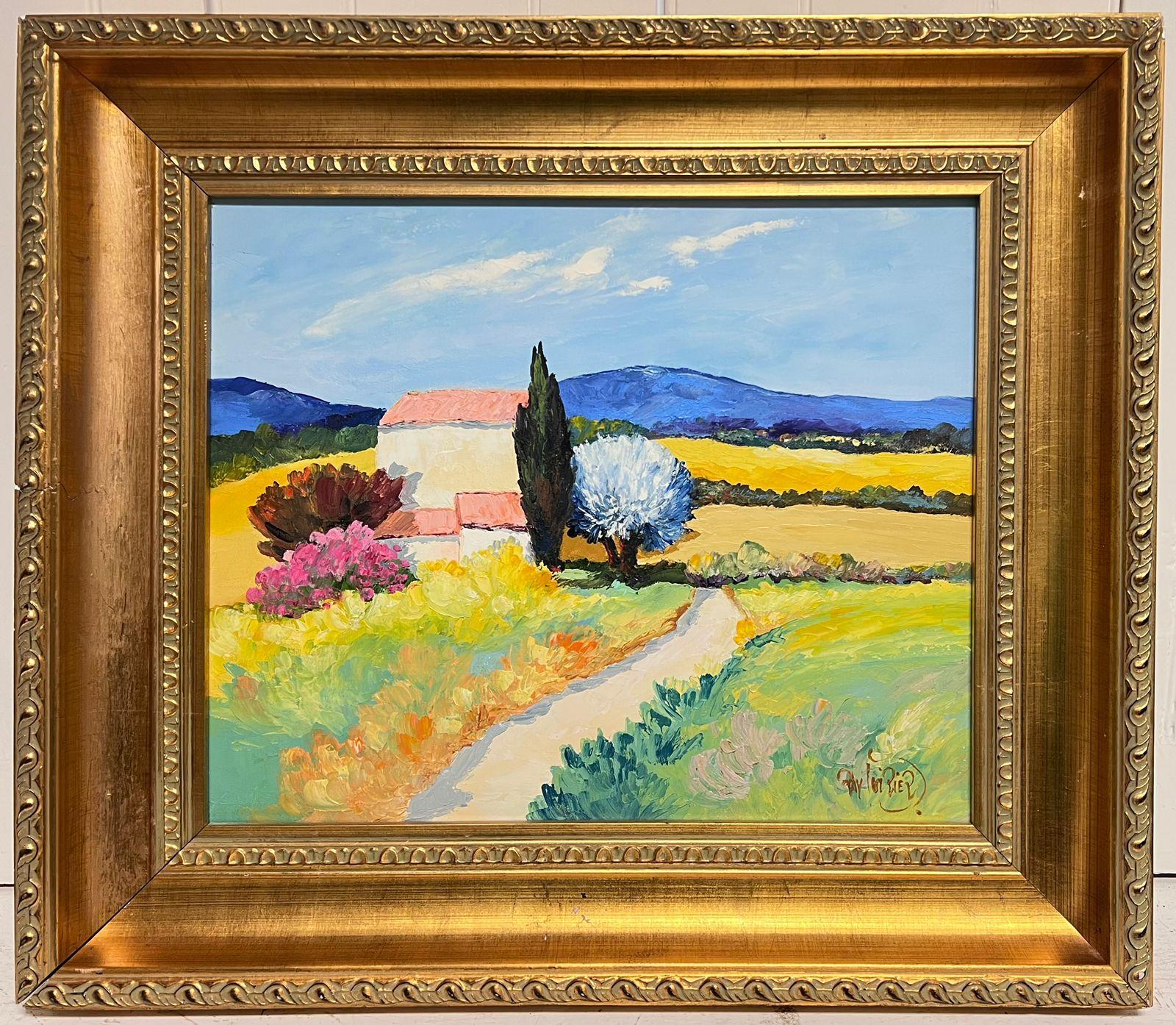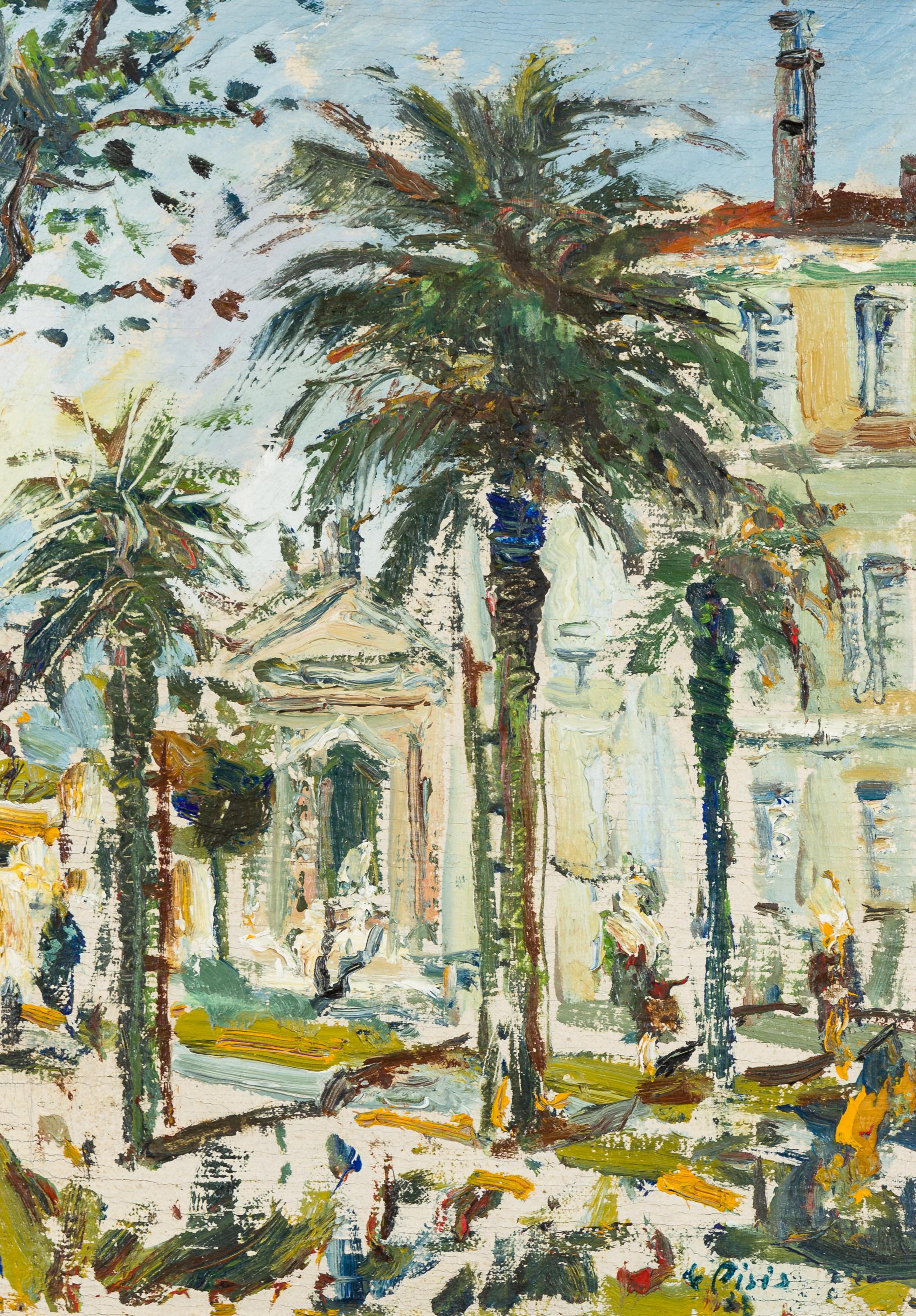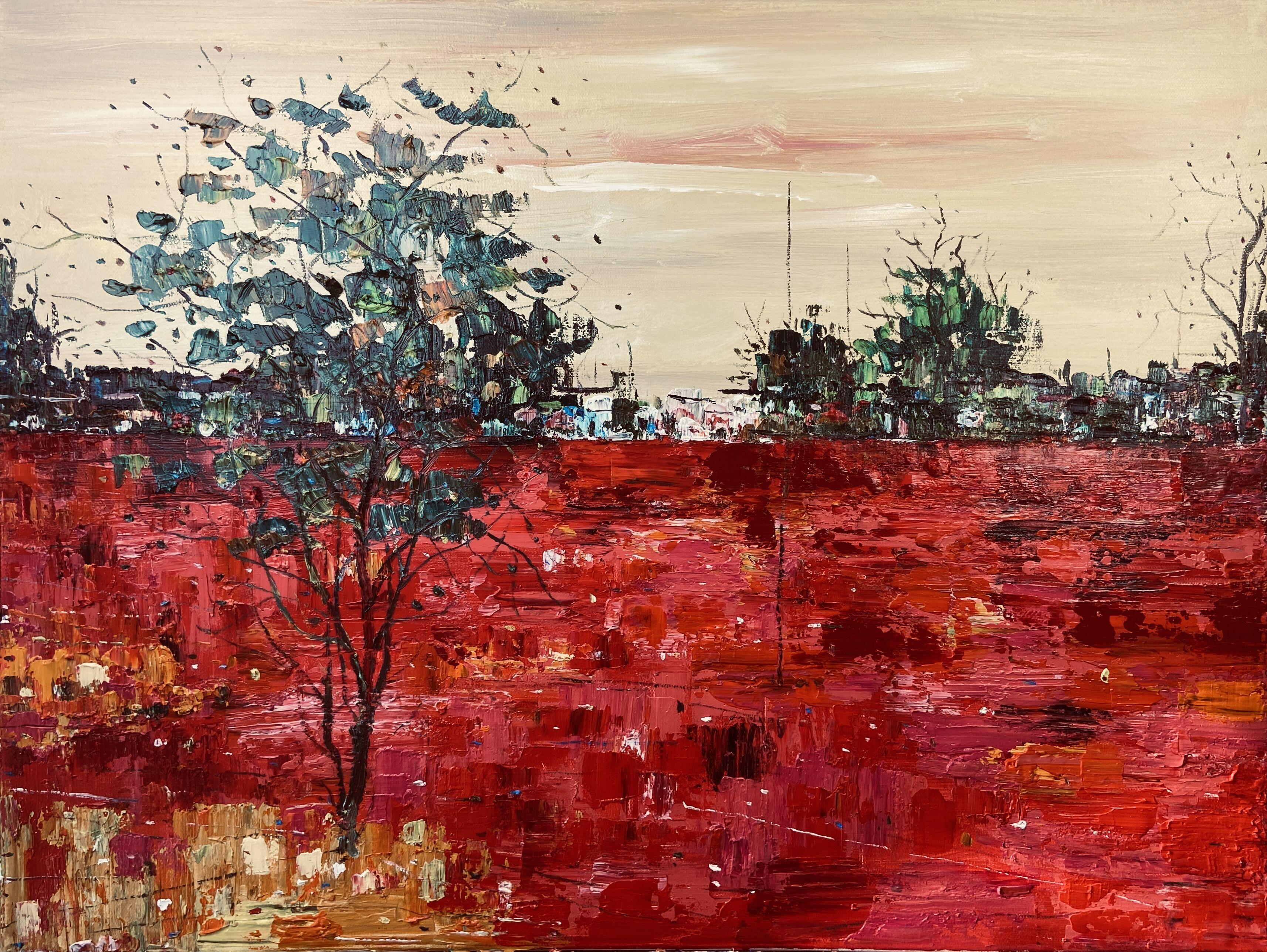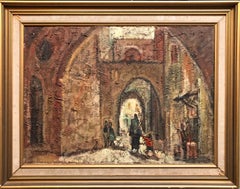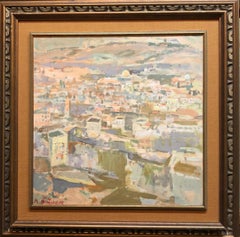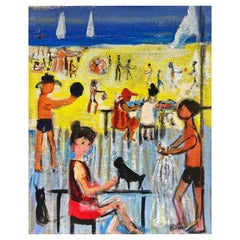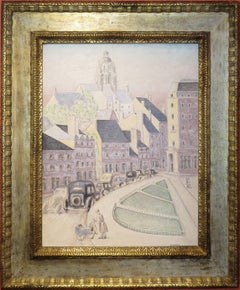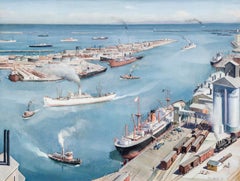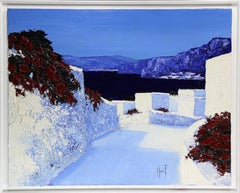
Island Landscape Impasto Oil Painting by Patrick Reault
View Similar Items
Want more images or videos?
Request additional images or videos from the seller
1 of 8
Patrick ReaultIsland Landscape Impasto Oil Painting by Patrick Reault
About the Item
- Creator:Patrick Reault (1955, French)
- Dimensions:Height: 39 in (99.06 cm)Width: 31.5 in (80.01 cm)Depth: 1.33 in (3.38 cm)
- Medium:
- Movement & Style:
- Period:
- Condition:
- Gallery Location:Surfside, FL
- Reference Number:1stDibs: LU3821036083
About the Seller
4.9
Platinum Seller
These expertly vetted sellers are 1stDibs' most experienced sellers and are rated highest by our customers.
Established in 1995
1stDibs seller since 2014
1,549 sales on 1stDibs
Typical response time: 1 hour
More From This SellerView All
- 1927 Oil Painting Eiffel Tower Paris American Modernist Wpa Artist Morris KantorBy Morris KantorLocated in Surfside, FLMorris Kantor New York (1896 - 1974) Paris from the Ile St. Louis, 1927 (view of Eiffel Tower) Oil painting on canvas Hand Signed lower left. Provenance: Hirshhorn Museum and Sculpture Garden, Smithsonian Institution ( bears label verso) Size: 20 3/4"H x 28 1/8"W (sight), 28.75 "H x 36"W (framed) Morris Kantor (Belarusian: Морыс Кантор) (1896-1974) was a Russian Empire-born American painter based in the New York City area. Born in Minsk on April 15, 1896, Kantor was brought to the United States in 1906 at age 10, in order to join his father who had previously relocated to the states. He made his home in West Nyack, New York for much of his life, and died there in 1974. He produced a prolific and diverse body of work, much of it in the form of paintings, which is distinguished by its stylistic variety over his long career. Perhaps his most widely recognized work is the iconic painting "Baseball At Night", which depicts an early night baseball game played under artificial electric light. Although he is best known for his paintings executed in a realistic manner, over the course of his life he also spent time working in styles such as Cubism and Futurism, and produced a number of abstract or non-figural works. A famous cubist, Futurist, painting of his "Orchestra" brought over 500,000$ at Christie's auction house in 2018 Kantor found employment in the Garment District upon his arrival in New York City, and was not able to begin formal art studies until 1916, when he began courses at the now-defunct Independent School of Art. He studied landscape painting with Homer Boss (1882-1956). In 1928, after returning to New York City from a year in Paris, Kantor developed a style in which he combined Realism with Fantasy, often taking the streets of New York as his subject matter. He did some moody Surrealist Nude paintings and fantasy scenes. In the 1940's he turned towards figural studies. Later in his career, Kantor himself was an instructor at the Cooper Union and also at the Art Students League of New York in the 1940s, and taught many pupils who later became famous artists in their own right, such as Knox Martin, Robert Rauschenberg, Sigmund Abeles and Susan Weil...Category
1920s American Modern Landscape Paintings
MaterialsCanvas, Oil
- Jerusalem Old City Cityscape Israeli Modernist Oil Painting Signed in HebrewLocated in Surfside, FLSigned Nathanson. Could be the famous artist Avraham Naton (Natanson) I am not certain. it is a very lovely Modernist Israeli landscape. Avraham Naton (Natanson), Israeli, born in Bessarabia, 1906-1959. Avraham Naton was born in Rani, Bessarabia to a large secular family. In 1935, after Art studies in Romania, he immigrated to the Land of Israel and settled, first, in Givat Haim and later in Ramat Gan. From the 1940s he worked as an Art teacher in Ramat Gan and Givataim. In 1948 he worked as an illustrator at BaMahane Newspaper. He was one of the Founders of New Horizon Group. Between 1952-1959 he was a member of the Milo Club and served as the club secretary. Education 1930-33 Art Academy, Bucharest, Romania Teaching 1940's Ramat Gan and Givataim Awards And Prizes Jerusalem Prize for Painting and Sculpture 1942 Dizengoff Prize 1953 Milo Club Prize New Horizons, The Ofakim Hadashim art movement began with a group of artists who mounted an exhibition in Tel Aviv's Habima national theater in December 1942, under the name "The Group of Eight". The group evolved into a coherent artistic movement only after the founding of the state of Israel in 1948. Members of the school included Arie Aroch, Zvi Meirovitch, Avraham Naton (Natanson), Avigdor Stematsky and Yehezkel Streichman. The work of sculptor Dov Feigin also appeared in the catalog of the 1942 exhibition, though it was not displayed. In February 1947 five of the original members of the group joined Joseph Zaritsky...Category
1950s Modern Landscape Paintings
MaterialsCanvas, Oil
- Large Abstract landscape of Jerusalem Israeli Oil Painting JudaicaBy Avraham BinderLocated in Surfside, FLAvraham Binder was born in 1906 in Vilnius (or Vilna), now part of Lithuania. He began painting at an early age and completed the prescribed studies in painting at the academy of art...Category
20th Century Modern Landscape Paintings
MaterialsOil, Canvas
- Austrian Magic Realist Oil Painting Vibrant Village Landscape Scene Franz CoufalLocated in Surfside, FLFramed 24.5 x 28.5 image 19.5 x 23 inches. Franz Anton Coufal (Austrian, 1927 - 1999) Painter and sculptor known for figure painting, bronze sculpture, genre paintings and as a graphic artist. After completing an apprenticeship as a locksmith, Franz Anton Coufal attended the Graphic Education and Research Institute in Vienna from 1947 to 1949 as a student of André Roder and from 1949 to 1953 took lessons from Ignaz Schönbrunner. From 1953 to 1959 he finally studied with Fritz Wotruba at the Academy of Fine Arts (diploma and master school award 1959). Coufal then went on study trips to Germany and Italy and then settled in Vienna as a sculptor and graphic artist. His work bears the influence of Austrian Magic Realism and the artists Friedensreich Hundertwasser, Arik Erich Brauer and Ernst Fuchs. THis work also has Expressionist elements to it. He organized exhibitions in Vienna (from 1955), Paris (1962, 1970) and Brussels (1964) as well as in other Austrian cities. His most important works include the honorary grave for Leopold Figl in the central cemetery (1966). In 1979 he provided the design for the face of the silver 100 schilling coin "Festival and Congress House Bregenz", in 1980 he created the Lehár monument for the city park, and in 1987 he received the special prize in the "Danube Region Vienna" competition. A select list of his sculptures in public spaces "Standing youth" (19, Hameaustraße - Celtesgasse, urban residential complex; 1960) "Reclining youth" (22, Kagran [Meißnergasse - Maißauer Gasse - Anton-Sattler-Gasse]; artificial stone, 1962) "Flammender Turm" (16, Thaliastraße 159; marble) Cubist marble sculpture (11, Molitorgasse at 15) Drinking fountain (20, Adalbert-Stifter-Straße primary school; 1968) Figldenkmal (1, Minoritenplatz, 1973) Coufal created some of his later works for the "Harmonie" rest home for the blind in Unterdambach near Neulengbach (memorial for the 144 blind people who perished in concentration camps, unveiled in 2000; stone sculpture "Monument to Humanity" on the terrace; rose-thorn cross and tabernacle for the in-house Odilien- Chapel; bronze portrait sculpture by Robert Vogel in the entrance hall, unveiled July 3, 1994). Bibliography Rudolf Schmidt: Austrian artist lexicon. From the beginning to the present. Vienna: Tusch 1974-1980 Who's Who in the world. Volume 2: 1974-1975. New Providence, NJ: Marquis Who's Who 1974 Who's who in the world. Volume 3: 1976-1977. New Providence, NJ: Marquis Who's Who 1976 Who is Who in Austria with South Tyrol part (Hübner's "Blue Who is Who"). Zug: Who is who, Verlag für Personalenzyklopädien 12 1995 Otto Breicha: Franz Anton Coufal In: Franz Anton Coufal. Österreichische Staatsdruckerei, December 9-22, 1964. Vienna: Staatsdruckerei 1964 The press, July 30, 1963 Of the generation of Viennese artists Alois Mosbacher, Josef Mikl, Oswald Oberhuber, Christian Ludwig Attersee, Peter Sengl, Max Weiler, Franz Ringel, Gunter Brus, Hubert Schmalix, Wilhelm Kaufmann, Paul Flora, Oscar Larsen, Hans Staudacher, Siegfried Anzinger, Ernst Huber...Category
20th Century Modern Landscape Paintings
MaterialsOil, Canvas
- Fishing Shack, School of Paris Barbizon Oil Painting Night Time Landscape, HorseBy Guy CambierLocated in Surfside, FLGuy Cambier Oil Painting (French, 1923-2008), "Cabane du Pêcheur", oil on panel, signed "Guy Cambier" at lower right, inscriptions verso, 23"h x 31.5"w (sight), 33.25"h x 41.75" with...Category
Mid-20th Century Modern Landscape Paintings
MaterialsCanvas, Oil
- King David, Jerusalem (after Marc Chagall) Oil Painting Israeli Judaica ArtBy Zammy SteynovitzLocated in Surfside, FLFramed 41.5 x 29.5 image 35.5 x 23.5 This large painting depicts a man and woman, Adam and Eve, interlocked and embracing one another. The woman holds an enticing apple as they are thrusted from the Garden of Eden. This is an original painting. Zamy Steynovitz was born in Liegnitz Poland, in 1951. He immigrated to Israel in 1957. The aspiration to be a painter stems from his childhood and before leaving Poland, he won the first prize in an art competition for children. Zamy was formally educated at the Art School in Tel-Aviv and at the Royal Academy of London. Upon completing his studies, Zamy earnestly pursued his career and establish his place in the art world by displaying his work in one man exhibits and arts fairs around the world. His art displays chromatic and thematic richness and his choice of subjects has been strongly influenced by Jewish tradition, his Eastern European Jewish heritage and folklore. Zamy’s popular themes include Paris cafes, still-life, flowers, circuses and landscapes. Circus with acrobats and Harlequin. In the early stages of his career, he was partial to rich pastels and light brush strokes. In the early 1980s, Zamy visited South America, where the new surroundings enhanced his work with local brightness and color. His art gained chromatic power and his palette became richer in tones as the textures became thicker and the background darker and more colorful. These changes coupled with his thematic persistence allowed him to develop into a sensitive and mature artist. Zamy expresses a universal humanistic vision in his creations: man’s connection to his heritage and physical surroundings, two imperative aspects of our lives that should be heralded during these estranged technological times. As a result of his devotion to world peace, Zamy is known in the circles of the Nobel Institute for Peace in Norway. He is acquainted with many Nobel Prize winners including Anwar Sadat, Menachem Begin, the Dalai Lama, Itzhak Rabin, Shimon Peres, Elie Wiesel, Desmond Tutu and Oscar Arias, the ex-President of Costa Rica, along with many other politicians and artists. Zamy tragically passed away in September 2000. Exhibitions One Man Show 1970 - Museum - Ramat - Gan 1973 - Brussels - Gallery L'Angle Aigu 1974 - London - International Gallery 1974 - Paris - Grand Palais Gallery 1975 - Milan - Brera Gallery 1976 - N.Y. Valentino Gallery - N.Y. Hilton 1977 - N.Y. Valentino Gallery - N.Y. Hilton 1978 - Basel - Actual Gallery 1978 - Geneve - Bohren Gallery 1978 - Oslo - Nobel Peace Prize Exhibit 1979 - London - Hamilton Gallery 1979 - N.Y. - Art Israel Kalt - Waldinger Gallery 1979 - N.Y. - Canty Art Gallery 1979 - Amsterdam - Schipper Gallery 1979 - Washington - International Art Fair 1980 - Cleveland -Jewish Museum 1980 - Tel-Aviv - Habima National Art Fair 1981 - Abraham - Goodman House N.Y. 1981 - San Lucas Galley - Bogota 1982 - Pedro Gerson Gallery - Mexico City 1983 - Simon Bolivar...Category
20th Century Modern Figurative Paintings
MaterialsCanvas, Oil
You May Also Like
- Large French Contemporary Modernist Oil Painting Figures Playing on Sunny BeachBy Huguette Ginet-LasnierLocated in Cirencester, GloucestershireBeach Games Huguette Ginet-Lasnier (French 1927-2020) oil painting on textured canvas 29 x 24 inches. All the paintings we have for sale by this artist have come from the artists estate in France. The painting is in very good and presentable condition. Color: Pink, green, black and white Ginet-Lasnier, the wife of the painter Jean Lasnier...Category
21st Century and Contemporary Modern Landscape Paintings
MaterialsOil, Canvas
- "Cityscape at Dusk"By John Bradley StorrsLocated in Lambertville, NJSigned Lower Right John Bradley Storrs (1885 - 1956) Born and raised in Chicago, John Storrs was a pioneer modernist sculptor known for his precisely executed, solid, non-objectiv...Category
20th Century Modern Landscape Paintings
MaterialsCanvas, Oil
- San Pedro HarborBy Paul SampleLocated in New York, NYIt is infrequent, to say the least, that a diagnosis of tuberculosis proves fortuitous, but that was the event, in 1921, that set Paul Starrett Sample on the road to becoming a professional artist. (The best source for an overview of Sample’s life and oeuvre remains Paul Sample: Painter of the American Scene, exhib. cat., [Hanover, New Hampshire: Hood Museum of Art, 1988] with a detailed and definitive chronology by Sample scholar, Paula F. Glick, and an essay by Robert L. McGrath. It is the source for this essay unless otherwise indicated.) Sample, born in Louisville, Kentucky, in 1896 to a construction engineer and his wife, spent his childhood moving with his family to the various locations that his father’s work took them. By 1911, the family had landed in Glencoe, Illinois, settling long enough for Paul to graduate from New Trier High School in 1916. Sample enrolled at Dartmouth College, in Hanover, New Hampshire, where his interests were anything but academic. His enthusiasms included the football and basketball teams, boxing, pledging at a fraternity, and learning to play the saxophone. After the United States entered World War I, Sample, to his family’s dismay, signed on for the Naval Reserve, leading directly to a hiatus from Dartmouth. In 1918 and 1919, Sample served in the U.S. Merchant Marine where he earned a third mate’s license and seriously contemplated life as a sailor. Acceding to parental pressure, he returned to Dartmouth, graduating in 1921. Sample’s undergraduate life revolved around sports and a jazz band he formed with his brother, Donald, two years younger and also a Dartmouth student. In November 1933, Sample summarized his life in a letter he wrote introducing himself to Frederick Newlin Price, founder of Ferargil Galleries, who would become his New York art dealer. The artist characterized his undergraduate years as spent “wasting my time intensively.” He told Price that that “I took an art appreciation course and slept thru it every day” (Ferargil Galleries Records, circa 1900–63, Archives of American Art, Smithsonian Institution, available on line). In 1920, Donald Sample contracted tuberculosis. He went for treatment to the world-famous Trudeau Sanitorium at Saranac Lake, in New York State’s Adirondack Mountains for the prescribed regimen of rest, healthful food, and fresh air. Visiting his brother in 1921, Paul also contracted the disease. Tuberculosis is highly contagious, and had no certain cure before the development of streptomycin in 1946. Even for patients who appeared to have recovered, there was a significant rate of recurrence. Thus, in his letter to Price, Sample avoided the stigma conjured by naming the disease, but wrote “I had a relapse with a bad lung and spent the next four years hospitalized in Saranac Lake.” The stringent physical restrictions imposed by adherence to “the cure” required Sample to cultivate an alternate set of interests. He read voraciously and, at the suggestion of his physician, contacted the husband of a fellow patient for instruction in art. That artist, then living in Saranac, was Jonas Lie (1880–1940), a prominent Norwegian-American painter and an associate academician at the National Academy of Design. Lie had gained renown for his dramatic 1913 series of paintings documenting the construction of the Panama Canal (The Metropolitan Museum of Art, New York; United States Military Academy, West Point, New York). Primarily a landscape artist, Lie had a particular affinity for scenes with water. His paintings, impressionistic, atmospheric, and brushy, never strayed from a realistic rendering of his subject. Sample regarded Lie as a mentor and retained a lifelong reverence for his teacher. Sample’s early paintings very much reflect Lie’s influence. ` In 1925, “cured,” Sample left Saranac Lake for what proved to be a brief stay in New York City, where his veteran’s benefits financed a commercial art course. The family, however, had moved to California, in the futile hope that the climate would benefit Donald. Sample joined them and after Donald’s death, remained in California, taking classes at the Otis Art Institute in Los Angeles. In Sample’s account to Price, “I couldn’t stomach the practice of painting a lot of High Sierras and desert flowers which seemed to be the only kind of pictures that were sold here so I got a job teaching drawing and painting at the art school of the University of Southern California.” Initially hired as a part-time instructor, Sample progressed to full-time status and ultimately, by the mid-1930s, to the post of Chairman of the Fine Art Department. Sample, however, did not want to wind up as a professor. “Teaching is all right in small doses,” he wrote, “but I have a horror of drifting into being a college professor and nothing more.” At the same time as he taught, Sample began to exhibit his work in a variety of venues at first locally, then nationally. Though he confessed himself “a terrible salesman,” and though occupied with continued learning and teaching, Sample was nonetheless, ambitious. In 1927, he wrote in his diary, “I am eventually going to be a painter and a damned good one. And what is more, I am going to make money at it” (as quoted by Glick, p. 15). In 1928, Sample felt sufficiently solvent to marry his long-time love, Sylvia Howland, who had also been a patient at Saranac Lake. The Howland family were rooted New Englanders and in summertime the Samples regularly traveled East for family reunion vacations. While the 1930s brought serious hardship to many artists, for Paul Sample it was a decade of success. Buttressed by the financial safety net of his teacher’s salary, he painted realist depictions of the American scene. While his work addressed depression-era conditions with a sympathetic eye, Sample avoided the anger and tinge of bitterness that characterized much contemporary realist art. Beginning in 1930, Sample began to exhibit regularly in juried exhibitions at important national venues, garnering prizes along the way. In 1930, Inner Harbor won an honorable mention in the Annual Exhibition of the Art Institute of Chicago. That same year Sample was also represented in a show at the Albright-Knox Gallery in Buffalo and at the Biennial Exhibition of the Corcoran Gallery of Art, Washington, D.C. In 1931, Dairy Ranch won the second Hallgarten Prize at the Annual Exhibition of the National Academy of Design, in New York. Sample also made his first appearances at the Carnegie Institute, Pittsburgh, and The Pennsylvania Academy of the Fine Arts, Philadelphia. In 1936, Miner’s Resting won the Temple Gold Medal at the Pennsylvania Academy’s Annual Exhibition. Always interested in watercolor, in 1936, Sample began to send works on paper to exhibitions at the Whitney Museum, New York. While participating in juried exhibitions, Sample also cultivated commercial possibilities. His first New York art dealer was the prestigious Macbeth Gallery in New York, which included his work in a November 1931 exhibition. In 1934, Sample joined the Ferargil Galleries in New York, after Fred Price arranged the sale of Sample’s Church Supper to the Michele and Donald D’Amour Museum of Fine Arts in Springfield, Massachusetts. In 1937, The Metropolitan Museum of Art purchased Sample’s Janitor’s Holiday from the annual exhibition of the National Academy of Design, a notable honor. As prestigious as this exhibition schedule may have been, by far Sample’s most visible presence in the 1930s and 1940s was the result of his relationship with Henry Luce’s burgeoning publishing empire, Time, Inc. Sample’s first contribution to a Luce publication appears to have been another San Pedro...Category
20th Century American Modern Landscape Paintings
MaterialsCanvas, Oil
- Spring in Dorset, 20th Century English Oil Landscape, Female ArtistLocated in London, GBOil on board Image size: 12 1/2 x 15 1/2 inches (31.75 x 40 cm) Contemporary style handmade frame Exhibitions 1952 Royal Academy of Arts Exhibition, Gallery no. VII, no.429. This forest scene invites the viewer into a multi-sensory event where the cool, damp shadows of the foliage can almost be felt and the rich bouquet of the forest floor recalled. Here, Sherlock has chosen a somewhat unusual angle and composition, dissecting each truck and tree form so that only a part can be seen. Furthermore, as we look into the depths of this space it becomes clear that we are stood gazing down into a valley that is in the distance, behind this wooded area. Indeed, instead of giving us an uninterrupted view of this vista, as perhaps would be expected, this view is deliberately blocked and our focus is directed instead towards the organic forms in the foreground. The Artist Marjorie Sherlock was born at Fir Tree Cottage, George Lane, Wanstead, Essex, on 3 February 1891, the elder child of the civil engineer, Henry Sherlock, and his wife, Alice (née Platts), who was born in Benares, India. By 1901, the family was living at ‘The Limes’, 121 Mill Road, Cambridge, and Marjorie received an education locally. In 1918, she entered into marriage with her cousin, Major Wilfrid Barrett, though this proved unsuccessful and they later divorced (he remarrying in 1941). She then continued to live at the family home until the Second World War. During the First World War, Marjorie Sherlock studied at Westminster Technical Institute under the Camden Town School painters, Walter Sickert and Harold Gilman. She exhibited at the Royal Academy of Arts from 1917, when she showed a powerful view of the interior of Liverpool Street Station (Government Art Collection) (to which the current etching [202] relates). In time, she would exhibit at the International Society, the New English Art Club, the Royal Society of British Artists, the Society of 207 Graphic Art and the Women’s International Art Club (becoming a member of the last two). She also showed work internationally. Developing as a printmaker as well as a painter, Sherlock studied etching under Malcolm Osborne at the Royal College of Art in 1925. She published her etchings in four series, the titles of which indicate her love of travel: ‘English Etchings, ‘Egyptian Etchings’ (both 1925), ‘German Etchings’ (1929) and ‘Indian Etchings’ (1932). During this period, she also visited the united States. More admiring of Continental painters than British ones, she furthered her studies, in 1938, by working in Paris under André L’Hôte and André Dunoyer de Segonzac. During the Second World War, Sherlock moved to East Devon and settled at Oxenways, a Victorian hunting lodge...Category
1950s Modern Landscape Paintings
MaterialsOil, Canvas
- The Little House in Provence Signed Original French Modernist Oil PaintingLocated in Cirencester, Gloucestershire"Le Mas" French Modernist artist, 21st century indistinctly signed lower corner oil on canvas, framed framed: 21.5 x 25.5 inches canvas: 15 x 18 inches provenance: private collection...Category
2010s Modern Landscape Paintings
MaterialsCanvas, Oil
- Till the Clouds Roll By 1945 Frank Sinatra Mid Century Modern Hollywood Film WPABy Richard WhorfLocated in New York, NYTill the Clouds Roll By 1945 Frank Sinatra Mid Century Modern Hollywood Film WPA TILL THE COULDS ROLL BY (Film Set), oil on canvas, 20 x 24 inches signed “Richard Whorf” lower right and signed and dated on the verso “R. Whorf/ Dec. 21, 1945. Frame by Hendenryk. ABOUT THE PAINTING This painting is from the collection of Barbara and Frank Sinatra, dated December 21, 1945 (just nine days after Frank Sinatra’s 30th birthday), and depicts the Metro-Goldwyn-Mayer Culver City backlot during the filming of Till the Clouds Roll By, the direction of the film having been taking over by Richard Whorf in December 1945. It is not presently clear if Whorf gave the Sinatras this painting as a gift, as the presence of the Dalzell Hatfield Galleries label on the verso indicates the painting may have been sourced there. Frank and Nancy Sinatra acquired a number of works from Dalzell Hatfield Galleries during the 1940’s, or perhaps they framed it for the couple. Sinatra performed “Old Man River’ in the film. Sinatra and June Allyson are depicted in the center of the painting. PROVENANCE From the Estate of Mrs. Nancy Sinatra; Dalzell Hatfield Galleries, Ambassador Hotel, Los Angeles. An image of the Dalzell Hatfield label and the back of the original frame (which we replaced with a stunning Heydenrk frame) are attached. Nancy Sinatra was Fran's first wife. Nancy Rose Barbato was 17 years old when she met Frank Sinatra, an 18-year-old singer from Hoboken, on the Jersey Shore in the summer of 1934. They married in 1939 at Our Lady of Sorrows Church in Jersey City where Frank gave Nancy a recording of a song dedicated to her titled "Our Love" as a wedding present. The young newlyweds lived and worked in New Jersey, where Frank worked as an unknown singing waiter and master of ceremonies at the Rustic Cabin while Nancy worked as a secretary at the American Type Founders. His musical career took off after singing with big band leaders Harry James and Tommy Dorsey...Category
1940s American Modern Landscape Paintings
MaterialsCanvas, Oil
